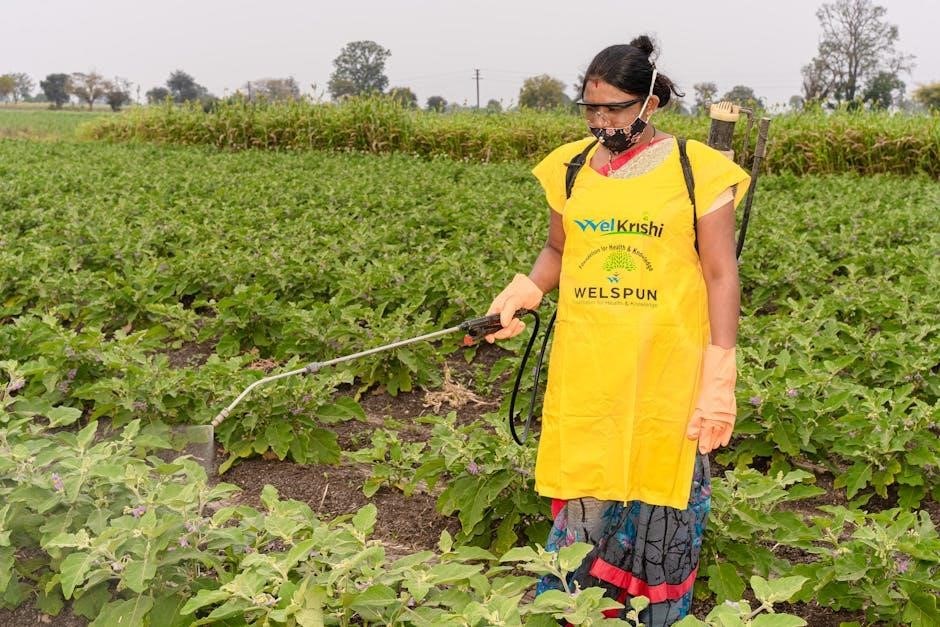Food Safety Manager Certification is a credential ensuring managers oversee safe food handling, preparation, and service. It is based on the FDA Food Code and ANSI exams.
This certification is crucial for protecting public health by preventing foodborne illnesses and ensuring compliance with food safety regulations and standards in food establishments.
The certification process involves passing a multiple-choice exam covering food safety practices, HACCP, and local health regulations, demonstrating competency in managing food safety systems.
Study guides, such as the Food Safety Manager Study Guide PDF, provide essential resources for understanding key concepts, preparing for exams, and maintaining food safety standards.
Continuous learning and certification updates are necessary as food safety regulations evolve, ensuring managers stay informed and effective in their roles.
Importance of Food Safety Manager Certification
Food Safety Manager Certification is crucial for ensuring safe food handling practices in food establishments. It verifies that managers possess the knowledge to prevent foodborne illnesses, protect public health, and comply with food safety regulations.
Certified managers are trained to identify and control food safety risks, implement HACCP systems, and maintain sanitary environments. This certification is often required by local health departments and is essential for food businesses to operate legally and responsibly.
By obtaining this certification, food safety managers demonstrate their commitment to safeguarding consumer health and upholding high food safety standards. It also enhances their leadership role in training staff and maintaining a culture of food safety within their organizations.
Overview of the Certification Process
The certification process for food safety managers involves completing a training program and passing an exam accredited by ANSI or other recognized organizations.
Training programs cover essential topics like foodborne illnesses, HACCP, and safe food handling practices, as outlined in the FDA Food Code and state-specific regulations.
Candidates must meet eligibility criteria, which may include completing a food safety course or having relevant work experience in the food industry.
The certification exam typically consists of multiple-choice questions testing knowledge of food safety standards, risk management, and regulatory compliance.
Upon passing the exam, individuals receive a certification valid for a specified period, often 3-5 years, after which they must recertify through continuing education or re-examination.
Study guides, such as the Food Safety Manager Study Guide PDF, are valuable resources to prepare for the exam and understand the certification requirements.

Understanding the Food Safety Manager Study Guide
The Food Safety Manager Study Guide is a comprehensive resource based on the FDA Food Code, covering essential topics like foodborne illnesses, HACCP, and safe handling practices.
It includes detailed sections on temperature control, sanitation, and regulatory compliance, ensuring managers are well-prepared for certification exams and real-world food safety challenges.
The guide also provides practice tests and assessment tools to help candidates gauge their readiness and focus on areas needing improvement.
Structure and Content of the Study Guide
The Food Safety Manager Study Guide is organized into clear modules, each focusing on specific aspects of food safety management. It begins with an introduction to food safety principles, followed by detailed sections on foodborne illnesses, safe food handling, and temperature control.
The guide also covers advanced topics such as HACCP plans, Good Manufacturing Practices (GMPs), and sanitation procedures. Each chapter includes practical examples, diagrams, and summaries to enhance understanding and retention of key concepts.
Additionally, the study guide incorporates practice exams and assessment tools to help candidates evaluate their knowledge and identify areas for further review. This structured approach ensures comprehensive preparation for the certification exam and real-world application of food safety practices.
Key Topics Covered in the Study Guide
The Food Safety Manager Study Guide PDF covers essential topics to ensure comprehensive understanding of food safety principles. It includes sections on foodborne illnesses, their causes, and prevention strategies, as well as safe food handling practices from procurement to service.
Key areas such as temperature control, hazard identification, and risk mitigation are thoroughly addressed, alongside detailed explanations of HACCP (Hazard Analysis Critical Control Point) systems and Good Manufacturing Practices (GMPs).
The guide also emphasizes regulatory compliance, including the FDA Food Code and state-specific health regulations, ensuring managers understand legal requirements for food safety.
Practical examples, diagrams, and summaries are included to simplify complex concepts, making the guide a valuable resource for both exam preparation and real-world application.
How to Effectively Use the Study Guide

To effectively use the Food Safety Manager Study Guide PDF, start by creating a structured study plan. Allocate time to review each section thoroughly, focusing on key concepts like foodborne illnesses, HACCP, and temperature control.
Utilize the practice tests included in the guide to assess your understanding and identify areas needing improvement. Review the answer keys to ensure comprehension of critical topics.
Highlight and annotate important sections to reinforce learning. Pay special attention to diagrams, charts, and summaries, as they provide visual aids for complex ideas.

Simulate exam conditions by setting timers during practice tests to build time management skills. Regularly revisit the guide to reinforce retention of food safety principles.
By following these strategies, you can maximize the study guide’s effectiveness, ensuring a strong foundation for both the certification exam and real-world food safety management.

Essential Concepts in Food Safety
Foodborne illnesses prevention, safe food handling, and temperature control are critical. Understanding contamination sources and proper sanitation ensures safe food preparation and service, reducing health risks.
Foodborne Illnesses and Their Prevention
Foodborne illnesses are diseases caused by consuming contaminated food, often leading to severe health issues. Common causes include pathogenic bacteria, viruses, parasites, and toxins. Proper food handling, storage, and cooking are critical to prevention. Understanding the temperature danger zone (41°F–135°F) is vital, as bacteria thrive in this range. Personal hygiene, clean equipment, and separation of raw and ready-to-eat foods reduce contamination risks. Regular training and adherence to HACCP principles ensure proactive control of hazards. Certified food safety managers play a key role in implementing these practices, protecting public health and ensuring compliance with food safety regulations. Prevention strategies are detailed in the Food Safety Manager Study Guide, emphasizing practical approaches to mitigate risks effectively.
Safe Food Handling Practices
Safe food handling practices are essential to prevent contamination and ensure food safety. These practices include proper handwashing, use of protective gear, and separation of raw and ready-to-eat foods. Food must be stored at appropriate temperatures, with perishables kept below 41°F and hot foods above 135°F to avoid the temperature danger zone. Regular cleaning and sanitizing of equipment and surfaces are critical to eliminate pathogens. Proper food handling also involves avoiding cross-contamination by using separate utensils and cutting boards for raw and cooked items. These practices are emphasized in the Food Safety Manager Study Guide to help managers implement effective food safety protocols. By following these guidelines, food establishments can reduce the risk of foodborne illnesses and maintain customer trust. Proper training and adherence to these practices are vital for certification and compliance with food safety regulations.
Temperature Control and Monitoring
Temperature control and monitoring are critical components of food safety. Food must be stored, prepared, and served at safe temperatures to prevent bacterial growth. The danger zone for bacterial growth is between 41°F and 135°F, where bacteria can double in number every 20 minutes. Perishable foods should be kept below 41°F for refrigeration and above 135°F for hot holding. Regular temperature checks using food thermometers ensure compliance with these standards. The Food Safety Manager Study Guide emphasizes the importance of monitoring temperatures throughout the food flow process, from receiving to serving. Proper temperature control is essential for preventing foodborne illnesses and ensuring food safety in all food establishments. Managers must train staff to maintain these practices consistently.

Food Safety Management Systems
Food safety management systems integrate HACCP, GMPs, and sanitation practices to ensure safe food production. These systems are crucial for identifying and controlling hazards, ensuring compliance with food safety standards, and maintaining customer trust.
HACCP (Hazard Analysis Critical Control Point)
HACCP is a systematic approach to identify and control hazards in the food production process. It focuses on preventing foodborne illnesses by addressing biological, chemical, and physical hazards. The HACCP system involves seven key principles: hazard analysis, identifying critical control points (CCPs), setting limits, monitoring CCPs, taking corrective actions, maintaining records, and verifying the system’s effectiveness. This method ensures food safety from production to consumption. HACCP is widely recognized and implemented in the food industry to comply with regulatory requirements and protect public health. The Food Safety Manager Study Guide PDF provides detailed insights into HACCP principles, helping managers understand and apply these practices effectively in their establishments. Proper HACCP implementation is essential for achieving food safety certification and maintaining customer trust.
Good Manufacturing Practices (GMPs)
Good Manufacturing Practices (GMPs) are guidelines that ensure food products are manufactured, processed, and packaged in a safe and sanitary environment. GMPs focus on preventing contamination and ensuring food safety by addressing factors like facility design, cleaning schedules, pest control, and employee hygiene. They also emphasize proper documentation and record-keeping to maintain traceability and accountability. GMPs are foundational for food safety management systems, including HACCP, and are critical for compliance with regulatory standards. The Food Safety Manager Study Guide PDF covers GMPs in detail, providing insights into their implementation and role in maintaining food safety. By following GMPs, food establishments can minimize risks, protect consumer health, and ensure consistent product quality.
Sanitation and Cleaning Procedures
Sanitation and cleaning procedures are critical for maintaining a safe food environment. These procedures involve regular cleaning of equipment, surfaces, and utensils to prevent contamination. The Food Safety Manager Study Guide PDF emphasizes the importance of sanitation schedules, proper use of cleaning agents, and pest control measures. Employees must be trained to follow these procedures consistently, with specific attention to high-risk areas like food preparation and storage zones. Proper sanitizing techniques, such as using the correct temperature and chemical concentrations, are essential to eliminate pathogens. Documentation of cleaning activities is also required to ensure compliance with food safety standards. By implementing robust sanitation practices, food establishments can significantly reduce the risk of foodborne illnesses and maintain a clean, safe environment for food handling.

Regulations and Standards
Food safety regulations and standards are established to ensure safe food handling and preparation. The FDA Food Code and state/local health regulations provide guidelines for food establishments. Compliance with these standards is critical for maintaining food safety and preventing foodborne illnesses. The Food Safety Manager Study Guide PDF outlines key regulations, including proper food handling, storage, and sanitation practices. Understanding and adhering to these standards is essential for certification and operational compliance in the food industry.
FDA Food Code and Its Relevance
The FDA Food Code is a science-based document providing guidelines for retail food establishments to ensure safe food handling and preparation. Updated periodically, it reflects current food safety knowledge and practices. The code is structured into chapters, covering topics like employee health, food handling, and temperature control. It serves as a reference for state and local health departments to develop their food safety regulations. Compliance with the FDA Food Code is essential for preventing foodborne illnesses and maintaining public health. The Food Safety Manager Study Guide PDF emphasizes understanding the FDA Food Code, as it is a critical component of the certification exam and real-world food safety management.
State and Local Health Department Regulations
State and local health departments play a crucial role in enforcing food safety standards, often adopting and expanding upon the FDA Food Code. These regulations may vary by jurisdiction, requiring food establishments to comply with specific licensing, inspection, and reporting requirements. Local health departments typically conduct regular inspections to ensure adherence to food safety practices, such as proper temperature control, hygiene, and pest management. The Food Safety Manager Study Guide PDF highlights the importance of understanding both federal and local regulations, as they often work together to protect public health. Familiarity with these rules is essential for food safety managers to maintain compliance and prevent foodborne illnesses effectively.

Preparing for the Certification Exam
Effective preparation involves a structured study plan, active learning techniques, and thorough review of key topics. Utilize practice tests to assess readiness and manage exam-day stress.
Study Tips and Exam Preparation Strategies
To excel in the food safety manager certification exam, adopt a systematic study approach. Begin by thoroughly reviewing the Food Safety Manager Study Guide PDF, focusing on key topics like foodborne illnesses, HACCP, and temperature control. Utilize active learning techniques, such as creating flashcards for critical terms and concepts. Practice with sample questions and review answer explanations to identify weak areas. Allocate dedicated study time each day, ensuring consistent progress. Additionally, join online forums or study groups to discuss challenging topics. Time management during the exam is crucial; allocate time evenly to each question and avoid spending too long on any single one. Lastly, ensure you are well-rested and mentally prepared on exam day to perform at your best.
Practice Tests and Assessment Tools
Practice tests are essential for effective exam preparation, offering insights into the actual certification exam format. Utilize the Food Safety Manager Study Guide PDF to access sample questions and assessment tools. These resources help identify knowledge gaps and strengthen understanding of critical topics. Many study guides include timed simulations of the exam, allowing candidates to refine their time management skills. Reviewing answer keys and explanations enhances learning by clarifying complex concepts; Additionally, online platforms offer interactive practice tests, providing immediate feedback and progress tracking. Regularly taking practice tests builds confidence and ensures readiness for the certification exam. Combine these tools with active study techniques for a comprehensive preparation strategy.

Role of a Certified Food Safety Manager
A certified food safety manager ensures food safety, trains staff, and maintains compliance with health regulations and standards in food establishments.
Responsibilities in Food Establishments
A certified food safety manager oversees food safety practices, ensuring compliance with regulations like the FDA Food Code and local health standards.
Key duties include monitoring food handling, maintaining proper temperature controls, and implementing sanitation procedures to prevent foodborne illnesses.
They are responsible for training staff on safe food practices and ensuring all food safety protocols are followed throughout the establishment.
Managers also conduct regular inspections and maintain documentation of food safety practices to ensure compliance with regulatory requirements.
Their role is critical in protecting public health and building customer trust in the food establishment’s safety standards.
Training and Supervising Staff
Certified food safety managers are responsible for training and supervising staff to ensure safe food handling practices across all levels of the food establishment.
They conduct regular workshops and one-on-one sessions to educate employees on key food safety concepts, such as proper hygiene, temperature control, and contamination prevention.
Managers also oversee staff tasks, providing feedback and correction to maintain high food safety standards and prevent foodborne illnesses;
By fostering a culture of food safety, they ensure all team members understand their roles in protecting customer health and adhering to regulatory requirements.
Effective training programs, supported by resources like the Food Safety Manager Study Guide PDF, help staff stay informed and compliant with food safety best practices.

Additional Resources for Success
- Study Guides: The Food Safety Manager Study Guide PDF offers comprehensive preparation materials.
- Practice Tests: Online practice exams help assess readiness for the certification exam.
- Webinars: Interactive sessions provide in-depth knowledge on food safety topics.
- Online Courses: Structured learning modules ensure thorough understanding of safety protocols.
Recommended Study Materials and Websites
For effective preparation, utilize the Food Safety Manager Study Guide PDF, which covers FDA Food Code and ANSI exam requirements.
- FoodManagerUSA.com offers a detailed study guide and practice tests to assess readiness.
- WesternFoodSafety.com provides downloadable study materials, including the 2021 Food Safety Manager Study Guide and practice tests in English and Spanish.
- Webinars and Online Courses: Platforms like Western Food Safety offer pre-recorded webinars and structured courses for in-depth learning.
These resources ensure comprehensive understanding of food safety concepts, HACCP, and local regulations, aiding in successful exam preparation and ongoing professional development.
Webinars and Online Courses
Enhance your preparation with webinars and online courses designed to complement the Food Safety Manager Study Guide PDF.
- Western Food Safety offers pre-recorded webinars covering key exam topics and study materials.
- Structured Courses: Platforms provide modular learning, focusing on HACCP, FDA regulations, and foodborne illness prevention.
- Interactive Learning: Engage with quizzes and real-world scenarios to reinforce concepts like temperature control and sanitation.
- Updated Resources: Access the latest 2021 Food Safety Manager Study Guide and practice tests for exam readiness.
These tools ensure a comprehensive understanding of food safety principles, aiding in successful certification and ongoing professional development.
Achieving Food Safety Manager Certification ensures expertise in safeguarding food, preventing foodborne illnesses, and adhering to regulations. The study guide is a vital resource for success.
Final Tips for Achieving Certification
To successfully obtain your Food Safety Manager Certification, thoroughly review the Food Safety Manager Study Guide PDF and practice with sample tests.
Focus on understanding key topics like HACCP, foodborne illness prevention, and temperature control, as these are critical for exam success.
Stay updated on the latest FDA Food Code and local health regulations, as these are frequently tested areas.
Use the study guide to identify weak areas and allocate extra study time to those sections.
Ensure you understand how to apply food safety concepts in real-world scenarios, as the exam often includes practical questions.
Stay calm and well-rested before the exam, and arrive early to avoid unnecessary stress.
Continuous learning after certification is essential to maintain expertise and comply with evolving food safety standards.
Continuous Learning in Food Safety
Continuous learning is essential for maintaining expertise in food safety and staying updated on evolving regulations and practices. The Food Safety Manager Study Guide PDF serves as a valuable resource for ongoing education, offering insights into new food safety standards and protocols.
Webinars, online courses, and professional certifications provide opportunities to expand knowledge and skills. Regular review of FDA Food Code updates, HACCP practices, and GMPs ensures compliance and effective food safety management.
Engaging with industry forums and attending workshops helps food safety managers stay informed about emerging trends and challenges. Continuous learning not only enhances professional competency but also contributes to a safer food environment for consumers.
By committing to lifelong learning, food safety managers can adapt to changes and maintain their critical role in protecting public health.

Leave a Reply
You must be logged in to post a comment.